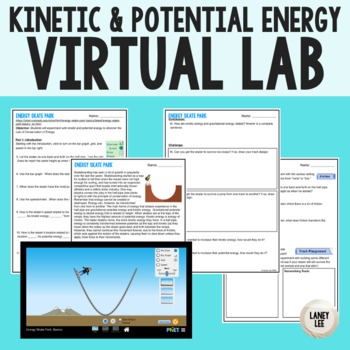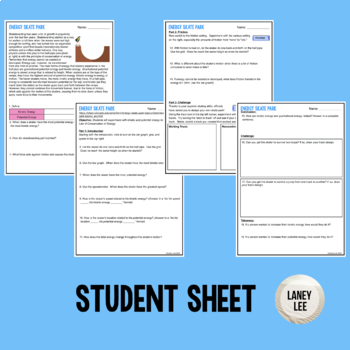Kinetic vs. Potential Energy Virtual Lab
- PDF
- Google Apps™
- Internet Activities
- Easel Activity

What educators are saying
Also included in
- Is lesson planning just too much on top of teaching on top of grading on top of classroom management on top of *ahem* living your life? Get all the resources you need to teach energy either in person, hybrid, or virtual with this great value-for-money bundle! These resources will save you time, enPrice $42.00Original Price $60.00Save $18.00
- Is lesson planning just too much on top of teaching on top of grading on top of classroom management on top of *ahem* living your life? Get all the resources you need to teach kinetic & potential energy either in person, hybrid, or virtual with this great value-for-money bundle! These resourcePrice $10.00Original Price $14.00Save $4.00
- Is lesson planning just too much on top of teaching on top of grading on top of classroom management on top of *ahem* living your life? Get all the guidance you need to teach a full-year physical science course in person, hybrid, or virtual with my all-inclusive curriculum bundle! This curriculum wPrice $268.00Original Price $383.99Save $115.99
Description
Using PhET simulations, students explore the relationship of kinetic and potential energy in a closed system. Students become aware of the Law of Conservation of Energy and also experiment with friction.
The original version of this lab uses the following web page:
https://phet.colorado.edu/en/simulation/energy-skate-park-basics
However, PhET has created a new and improved version of this sim available here:
https://phet.colorado.edu/sims/html/energy-skate-park/latest/energy-skate-park_all.html
This resource includes student pages for BOTH simulations which you choose between or use as differentiation.
The original sim has 3 parts:
- Introduction (no friction)
- Friction (with friction)
- Playground (free play)
The updated sim has 4 parts:
- Introduction (with and without friction, based on settings)
- Measure (worksheet incorporates a math portion)
- Graphs
- Playground (free play)
Both versions of this lab also come with answer keys and digital versions using Google Slides.
Who is this resource for?
This resource can be used by classroom teachers, tutors, and parents of students in grades 6-9. It comprehensively covers the topics mentioned, and provides opportunities for student responses which can be implemented in a whole group lesson or assigned for homework. Ideal for classrooms with internet access and student devices.
How Can I Use this Resource?
- Emergency Sub Plans
- An independent work station in a set of stations
- Flipped Classroom pre-reading
- Whole or small group opportunity to model and teach Close Reading strategies and annotation
- Differentiation – Assign this virtual lab as reteaching for students who have yet to show mastery.
- Homework
- Creation of Independent Work Packet for students who are not able to be present for direct instruction.
- Extension activity for early finishers or for students who show a special interest in the topic
- Use as a square on a Choice Board
- Interactive Notebooks: Print 2 pages in one and cut apart. Glue mini pages into notebooks with room for annotations on the side
- Interactive Notebooks: Print entire PDF as a mini booklet and add to notebooks using thesesimple instructions.
What's Included?
Purchase includes a printable PDF file in color. On page 2 of this resource you will find a link to a student friendly Google Slide version of this file. You will be able to copy this file and use it with Google Classroom or any other paperless initiative.
Please take a look at the preview file to see more of this resource.
This is an Easel Resource Too!
We know you're busy, so this resource has already been prepped for use in Easel by TPT. That means that in the Easel Activity, all non-student pages have been removed and answer boxes have been added where they're needed. You can assign this resource to your students as a fillable PDF just seconds after purchasing, with no extra steps on your end.
More questions?
Email me at laneyleeteaches@gmail.com.
-------------------------------------------------------------------------------------------------------------------------------
More on energy:
- Kinetic vs. Potential Energy Google Slides Presentation
- Kinetic vs. Potential Energy Guided Reading
- Kinetic vs. Potential Energy Practice
- Newton's Laws Color by Number
- Forms of Energy Presentation
- Forms of Energy Color by Number
- Forms and Transformations Quiz
- Transformations Presentation
- Homework Pages
- Energy One Pager
- ENERGY ACTIVITY BUNDLE (SAVE 30%)
-------------------------------------------------------------------------------------------------------------------------------
To stay updated on sales and new products, please follow my store:
Connect and chat with me!









